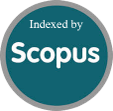Comparative evaluation of microbial activity in the decomposition of organic matter from solid household waste in Guayaquil
DOI:
https://doi.org/10.51798/sijis.v5i1.713Keywords:
Conidial, Psychrophilic, Mesophilic, Thermophilic, solid organic waste.Abstract
The escalating global population and subsequent rise in consumerism underscore the critical need for proper solid waste management, with a specific focus on the daily disposal of organic waste. Inadequate waste management poses direct threats to public health, as uncontrolled fermentation provides a fertile ground for bacterial growth. This study explores the efficacy of employing Microorganisms, specifically comparing Trichoderma to a Microbial Biocatalyst, for the treatment of daily solid organic waste (D.S.O.W.). Following Falconi's (2013a) methodology for the capture, multiplication, and conidial count of microorganisms, a pilot study utilizing a Bioreactor was conducted. The statistical analysis of parameters such as Humidity, Weight, pH leachates, Temperature, Time, and Volume, with corresponding ANOVA significance levels, resulted in the rejection of null hypotheses for most parameters, except pH m.o. The capture and multiplication of Trichoderma spp. microorganisms reached a count 7.6×109 /ml. Treatment 6 (T6) emerged as more effective and efficient in decomposing organic matter (OM), exhibiting distinct stages of psychrophilic, mesophilic (3 days), thermophilic (6 days), psychrophilic (3 days), and cooling (3 days), culminating in the decomposition of OM in 15 days within the bioreactor. The results validate the working hypothesis, affirming the potential of Microorganisms, especially Trichoderma, in enhancing the treatment of daily solid organic waste.
References
Armijo de Vega, C., Ojeda Benítez, S., Ramírez Barreto, E. (2008). Solid waste characterization and recycling potential for a university campus. Waste Management, Volume 28, Supplement 1. https://doi.org/10.1016/j.wasman.2008.03.022
Bao, Y., Feng, Y., Qiu, C., Zhang, J., Wang, Y., & Lin, X. (2021). Organic matter-and temperature-driven deterministic assembly processes govern bacterial community composition and functionality during manure composting. Waste Management, 131, 31-40
Barradas Rebolledo, A. (2009). Gestión integral de residuos sólidos municipales. Veracruz, México. 82 p.
Barrena, R., Vázquez, F., & Sánchez, A. (2006). The use of respiration indices in the composting process: A review. Waste Management & Research, 24(1), 37-47. https://doi.org/10.1177/0734242X06062385
Bernal M.P., Alburquerque J.A., & Moral R. (2009). Composting of animal manures and chemical criteria for compost maturity assessment. A review. Bioresour. Technol, 100(22). 5444-5453. https://doi.org/10.1016/j.biortech.2008.11.027
Cánovas, A. (1993). Tratado de Agricultura Ecológica. Editado Instituto de Estudios Almerienses de la Diputación de Almería. Almeria, España.
Falconi Borja, C. J. (2013a). Construcción de laboratorio para Trichoderma (entrevista). Laboratorio de Biotecnología “IAJJCZ”. Limoncito, Sata Elena.
Falconi Borja, C. J. (2013b). Manejo e implementación de un banco de microorganismos nativos tipo Trichoderma. Manejo y manipulación de germoplasma Trichoderma para la preservación y acceso a la multiplicación masiva. Quito, Ecuador. 9 - 10 pp.
Falconi Borja, C. J. (2013c). Sistema de producción masiva de Trichoderma spp. Quito, Ecuador. 14 - 15 pp.
García, C., Hernández, T. & Costa F. (1994). Microbial activity in soils under mediterranean environmental conditions. Soil Biology and Biochemistry, Volume 26, Issue 9. (pp. 1185-1191). https://doi.org/10.1016/0038-0717(94)90142-2
Grant, W. D. y Long P. E. (1989). Microbiología ambiental, 1er Capítulo. Zaragoza, España: Editorial ACRIBIA S.A. 222 p.
Liu, X., Rong, X., Yang, J., Li, H., Hu, W., Yang, Y., ... & Zhang, J. (2023). Community succession of microbial populations related to CNPS biological transformations regulates product maturity during cow-manure-driven composting. Bioresource Technology, 369, 128493.
Negrete-Yankelevich, S., Fragoso, C., Newton, A., & William Heal, O. (2007). Successional changes in soil, litter and macroinvertebrate parameters following selective logging in a Mexican Cloud Forest. Applied Soil Ecology, Volume 35, Issue 2. 340-355. ISSN 0929-1393. https://doi.org/10.1016/j.apsoil.2006.07.006.
Peña E. y Carrión M. (2002). Manual para la producción de abonos orgánicos en la agricultura urbana. La Habana, Cuba: Edición INIFAT.
Porta J., López-Acevedo M., y Roquero C. (1994). Edafología para la agricultura y el medio ambiente. Madrid, España: Editorial Mundi-Prensa.
Rastogi, M., Nandal, M., & Khosla, B. (2020). Microbes as vital additives for solid waste composting. Heliyon, 6(2), e03343. https://doi.org/10.1016/j.heliyon.2020.e03343
Ruiz, A. (1998). Tratamiento de residuos sólidos. La gestión de los residuos domésticos. Fundación Universitaria Iberoamericana. 82 p.
Tuomela, M., Vikman, M., Hatakka, A., & Itävaara, M. (2000). Biodegradation of lignin in a compost environment: A review. Bioresource Technology, 72(2), 169-183. https://doi.org/10.1016/S0960-8524(99)00104-2
Vázquez, M. A., Soto, M., Pérez, J., & Marañón, E. (2007). Microbiological and biochemical properties of artificial substrates: A preliminary study of its application to soil restoration in semiarid environments. Applied Soil Ecology, 35(2), 238-246. https://doi.org/10.1016/j.ecoleng.2014.05.003
Downloads
Published
How to Cite
Issue
Section
License
Copyright (c) 2024 Carlos Alberto Nieto-Cañarte, Victor Manuel Guaman-Sarango , Angelita Leonor Bosquez-Mestanza, Carmen Alexandra Sinchi-Rivas, Nelson Luis Mecias-Herrera

This work is licensed under a Creative Commons Attribution-NonCommercial-NoDerivatives 4.0 International License.




